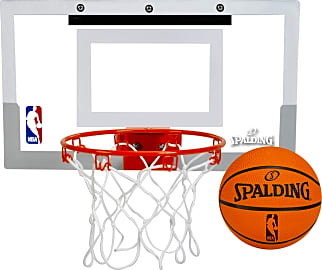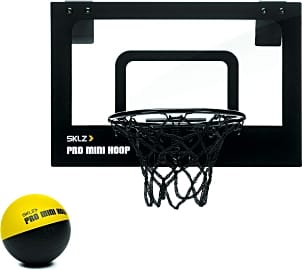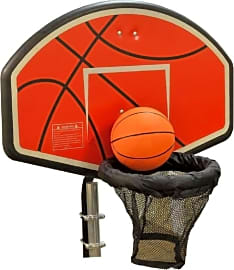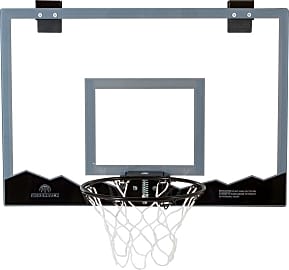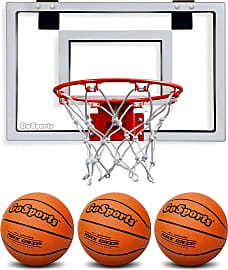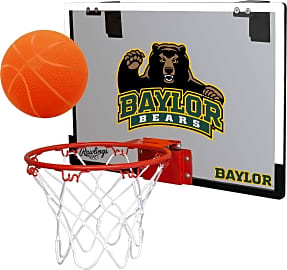The 10 Best Mini Hoops

This wiki has been updated 45 times since it was first published in September of 2015. Just because you got no space indoors, doesn't mean you got no game. You can easily set up one of these mini hoops inside your home and get dunking in no time. They're great for all ages, and come in fun, budget-friendly options, as well as sturdier models that feature breakaway rims and tough backboards that can take a beating. We've included both over-the-door and wall-mountable options. When users buy our independently chosen editorial picks, we may earn commissions to help fund the Wiki.
Editor's Notes
November 03, 2020:
After reviewing the list for availability, only the JustInTymeSports Pro Xtreme 5007 seemed to be having issues, so we removed it for the time being. There wasn't a suitable like-for-like replacement as this item was one of the few on the market that featured a robust double strut wall mount like the popular Ramgoal 01.
Instead, we used the free place to add the JumpKing Basketball, which attaches to one of the upright poles of your trampoline enclosure frame, allowing you to bounce and dunk almost as high as you wish.
We kept the rest of the options as they were. They span a broad spectrum of specifications, with some models mounted on the wall, while others hang on the door, and one model even being freestanding. There's options for kids only, stronger versions for adults, ones that can be height-adjusted so both children and parents alike can use them, and ones with special features such as lighting up in the dark or sporting the name of your school's team on the backboard.
December 21, 2019:
When inclement weather or work keeps you from getting outdoors and playing some b-ball, these mini hoops can save they day. They allow you to practice your three pointers and slam dunks right from the comfort of your bedroom or office.
The wall-mountable Ramgoal 01 and JustInTymeSports Pro Xtreme 5007 probably best replicate playing on a full-sized backboard. Since they don't wobble at all when the ball hits them, they offer the most true-to-life rebound. They also both feature a spring-loaded, breakaway rim, so you can dunk as hard as you want on them. Adding to the appeal of the Ramgoal 01 is the fact that it is height adjustable, so adults and older kids can set it higher, and then it can be lowered for young kids to make things a bit easier for them.
If a simple mini hoop doesn't hold enough excitement for you, the illuminated Franklin Sports Over The Door 54272X might be a good choice. It flashes every time you make a basket, and it features a digital scorekeeper. Of course, if authenticity is what you are after and you are dead set on the convenience of an over-the-door model, the Spalding NBA Slam Jam is a no-brainer, as it comes from the same company that makes official game-day basketballs.
While all of our selections are designed to be used indoors, though the Little Tikes EasyScore is just as suitable for outdoor use too, the Sklz Pro Micro is a smart choice if you are worried about your walls getting scuffed. It comes with a soft foam ball that shouldn't leave any marks, and which is also quieter when it does hit those walls than hard rubber options.
The Developmental Benefits of Basketball
That's where a mini hoop - and a mini basketball - can come in handy.
Athletics are a tremendous way to encourage any child's physical development, especially from a young age. Basketball, in particular, is beneficial in that it teaches - and then reinforces - hand-eye coordination, speed, agility, strength, endurance, balance, and a variety of other motor skills.
Teaching a child to play basketball (or almost any type of organized sport) is also proven to benefit that child psychologically, by instilling confidence and a competitive spirit. As the child approaches an age where he or she can play on a team, that initial foundation will provide something to build on. Along those lines, it's worth noting that participating in youth athletic leagues has a resounding impact on any child's social dealings, including his or her ability to function in a group, or aspire to any type of leadership position as an adult.
Obviously, a regulation basketball is too large for any kindergartner, just as a regulation basket is too high. That's where a mini hoop - and a mini basketball - can come in handy. Teaching your child how to dribble, aim, and shoot with a mini hoop isn't only fun and engaging, it'll also help your child to build strong leg muscles while promoting cardiovascular health.
Several Safety Tips For Owning a Mini Hoop
If you're a parent whose child plays with a mini hoop inside the house, it's best to position that hoop in a wide open section of a rec room or a basement. Make sure the mini hoop stands clear of any windows, framed photos, furniture, or artwork, and that the floor is clear of any toys - or other objects - that a child might turn an ankle on, or worse.
If you're a parent whose child plays with a mini hoop inside the house, it's best to position that hoop in a wide open section of a rec room or a basement.
If you place the mini hoop outside, try and keep it away from any fences, so that the ball cannot bounce into the street, or into any nearby yards. Keep the hoop at a remove from any shingles, siding, vehicles, potted plants, or patio furniture, and, if possible, add some outdoor lighting so that your children can play at night. As a precaution, make sure to anchor the mini hoop so that it cannot get knocked over or stolen.
Beyond that, you may want to make it standard practice to hide the mini hoop's basketball whenever it isn't being used. This way you can withhold the ball until all homework or requisite chores have been completed, and you can also ensure that a preschool child doesn't have access to the ball without any supervision. If your child shows an interest in learning the actual fundamentals of basketball, be sure to buy him or her a pair of high tops before transitioning onto a court.
A Brief History of Basketball (By Way of Its Baskets)
The first-ever basketball game was played as part of a YMCA gym class during December of 1891. This class, which was moderated by a Massachusetts physician named James Naismith, consisted of 18 boys, who had been divided into a pair of nine-player groups. The objective of the game, according to Naismith, was to bounce, or dribble, a soccer ball before passing or shooting it toward one of two peach baskets. The peach baskets had been set up along opposing sides of a hall.
Basketball nets were redesigned in 1906, however, so that the bottom end sat open, thereby allowing the ball to drain out free onto the floor.
Over the next year, Naismith facilitated a number of scrimmages, which he used to create what he called his 13 Basic Rules of Basket Ball. Among these rules was the notion that a soft leather ball should be used to minimize injuries, that a player could not run while holding the ball, and that it should be a violation for any player to directly block the opposing team's basket.
Around 1900, Dr. Naismith's original peach baskets were replaced by metal hoops. For a time, these hoops had closed nets, a reality which forced players, coaches, or referees to pop the ball out with a broomstick every time that someone scored. Basketball nets were redesigned in 1906, however, so that the bottom end sat open, thereby allowing the ball to drain out free onto the floor.
Basketball began to flourish by way of collegiate clubs, and the game's popularity eventually led to a professional league - the BAA, or Basketball Association of America - being formed in 1946. A few years later, the BAA merged with the NBL (i.e., the National Basketball League) to create the NBA (i.e., the National Basketball Association). Throughout the 1960s and the early 1970s, the NBA would compete with the ABA (i.e., the American Basketball Association), prompting an ongoing debate over what the regulation dimensions of a hoop and its backboard should be. That debate was ended once and for all when the ABA and the NBA merged during 1976.
Under official NBA rules, it was decided that a basketball rim should measure 18 inches in diameter, and that any goal should stand exactly 10 feet off the ground. It was additionally decided that a regulation backboard should measure 72 inches by 42 inches, and that it should feature a painted rectangle above the hoop that measures 24 inches by 18 inches long. The NBA transitioned to glass backboards so that every spectator would have a clear view, and the league eventually upgraded to what are known as breakaway rims, thereby minimizing the chances that any backboard might shatter during the middle of a game.



